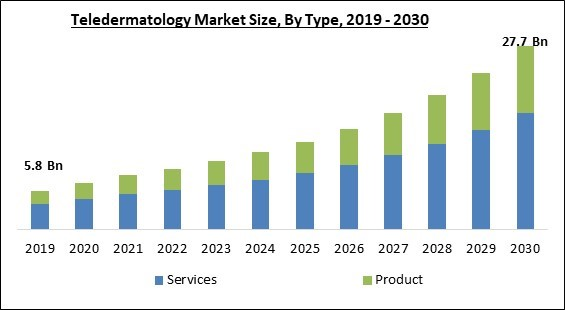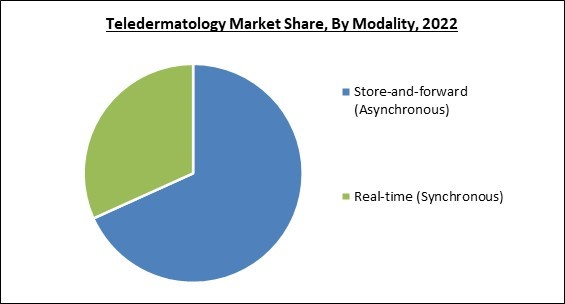IT advancements have provided the industry with an ever-expanding range of options, including more stable broadband networks, mobile devices with sophisticated cameras for defined images, HD videoconferencing, and electronic health records. This has provided dermatologists with vast opportunities. Therefore, the Teleconsultation segment will capture a 1/4thshare by 2030. Patients can now communicate with dermatologists from the comfort of their residences, saving time and effort. The increased demand for virtual consultations has made dermatological care more accessible to a larger population. Some of the factors impacting the market are Increase in prevalence and severity of dermatological disorders, Utilization of Artificial Intelligence (AI) to Promote Market Development, and Regional regulatory variations.
The prevalence of dermatological problems among consumers around the world is rising. Young people are aging quickly due to unhealthy lifestyle choices and inadequate nutrition. Fast food has a lot of additives, chemicals, sugar, salt, and bad fats that can lead to skin conditions, high blood pressure, and obesity. People all across the world are developing serious skin illnesses as a result of increased exposure to pollution. People frequently take extra care of them to ensure that their body and skin look attractive and healthy. Additionally, Artificial intelligence integration is one of the major trends driving market expansion. Fast-growing telemedicine programs and long-distance consultations are being accepted by healthcare institutions. Teledermatology has been used to diagnose cases of melanoma using brand-new developments in deep learning, a type of artificial intelligence (AI). With the potential to enhance clinical procedures, decision-making, and workflow in dermatology practice, AI is presenting itself as a technological possibility. The market growth is expected to be influenced due to growing awareness of people and the increasing incorporation of AI in teledermatology.
Furthermore, the COVID-19 pandemic is anticipated to have a significant impact on the market over the study period, with a solid increase. This is as a result of the COVID-19 pandemic's dramatic acceleration of the use of telemedicine and teledermatology. There was a considerable decrease in the number of patient visits and consultations because of the lockdown and social isolation policies implemented to stop the coronavirus's spread. As a result, the teledermatology concept acquired considerable support during the pandemic, which benefited the market both during and after the pandemic era.
However, there are significant differences in laws and policies governing telehealth and telemedicine operations between states and countries and a paucity of specifications. For instance, different states in the United States represent a muddled scenario, as they have varying guidelines for gaining patient consent before a telemedicine visit. These regulatory barriers restrain the telehealth and telemedicine markets and will continue to do so unless unified laws are enacted to ensure seamless and streamlined operations.
Type Outlook
Based on type, the market is segmented into products and services. In 2022, the services segment held the highest revenue share in the market. The product segment's expansion is anticipated due to the increasing demand for dermatoscopes capable of capturing images with more detail for accurate diagnosis. The worldwide deficiency of dermatologists has facilitated the emergence of teledermatology, drastically reducing patient wait periods for services.Modality Outlook
By modality, the market is classified into store-and-forward (Asynchronous) and real-time (Synchronized). The real-time segment recorded a remarkable revenue share in the market in 2022. Tele- dermatology entails the use of video conferencing apparatus and telecommunications to provide remote medical consultation and treatment. Due to the increasing prevalence of acne, hair loss, and other skin-related issues, video conferencing with dermatologists is preferred, fueling the segment's growth.Service Outlook
On the basis of service type, the market is fragmented into teleconsultation, telemonitoring, and tele-education. In 2022, the teleconsultation segment witnessed the largest revenue share in the market. Using teleconsulting, patients in remote or underserved areas can gain access to specialized dermatology services without having to travel great distances. This enhanced access can increase demand for teledermatology services.End-user Outlook
Based on end users, the market is segmented into healthcare units and home care. In 2022, the homecare segment registered the largest revenue share in the market. Rising disposable income, increased healthcare expenditures, and a growing geriatric population are expected to be the primary factors driving the growth of the homecare segment over the next few years.Regional Outlook
Region wise, the market is analyzed across North America, Europe, Asia-Pacific, and LAMEA. In 2022, the North America region led the market by generating the highest revenue share. This is due to a rise in awareness regarding teledermatology services, an increase in the prevalence of skin diseases, the strong presence of key actors offering teledermatology services, and the availability of an advanced healthcare system and modern medical technologies. In addition, the United States is anticipated to account for a significant portion of the market due to several factors, such as the existence of key service providers and the growing awareness of the advantages of teledermatology services.The market research report covers the analysis of key stake holders of the market. Key companies profiled in the report include Ksyos, MetaOptima Technology, Inc., Veradigm, Inc., McKesson Corporation, Teladoc Health, Inc., FirstDerm, 3M Company (3M Health Information Systems), Siemens Healthineers AG (Siemens AG), DermUtopia and Digital Diagnostics, Inc. (3Derm Systems, Inc.).
Scope of the Study
By Type
- Services
- Teleconsultation
- Telemonitoring
- Tele-education
- Product
By Modality
- Store-and-forward (Asynchronous)
- Real-time (Synchronous)
By End-user
- Homecare
- Healthcare Units
By Geography
- North America
- US
- Canada
- Mexico
- Rest of North America
- Europe
- Germany
- UK
- France
- Russia
- Spain
- Italy
- Rest of Europe
- Asia Pacific
- China
- Japan
- India
- South Korea
- Singapore
- Malaysia
- Rest of Asia Pacific
- LAMEA
- Brazil
- Argentina
- UAE
- Saudi Arabia
- South Africa
- Nigeria
- Rest of LAMEA
Key Market Players
List of Companies Profiled in the Report:
- Ksyos
- MetaOptima Technology, Inc.
- Veradigm, Inc.
- McKesson Corporation
- Teladoc Health, Inc.
- FirstDerm
- 3M Company (3M Health Information Systems)
- Siemens Healthineers AG (Siemens AG)
- DermUtopia
- Digital Diagnostics, Inc. (3Derm Systems, Inc.)
Unique Offerings
- Exhaustive coverage
- The highest number of Market tables and figures
- Subscription-based model available
- Guaranteed best price
- Assured post sales research support with 10% customization free
Table of Contents
Companies Mentioned
- Ksyos
- MetaOptima Technology, Inc.
- Veradigm, Inc.
- McKesson Corporation
- Teladoc Health, Inc.
- FirstDerm
- 3M Company (3M Health Information Systems)
- Siemens Healthineers AG (Siemens AG)
- DermUtopia
- Digital Diagnostics, Inc. (3Derm Systems, Inc.)










